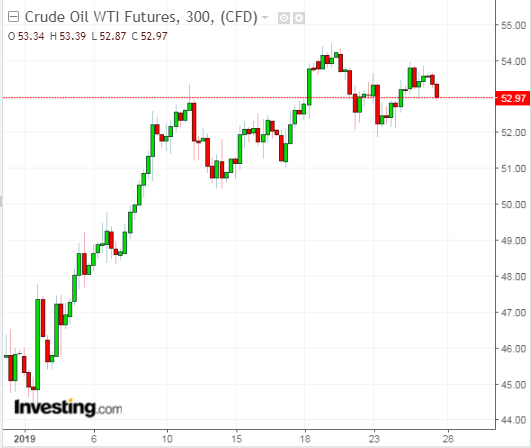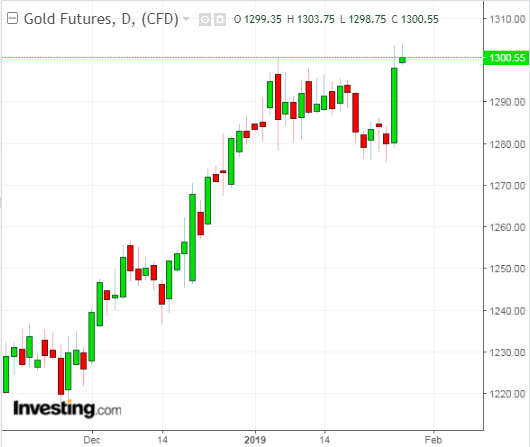Just as gasoline stockpiles reached record highs and the oil rig count rebounded, potential sanctions against Venezuelan oil have thrown a lifeline to U.S. crude amid deteriorating fundamentals that question the $50-per-barrel support for the market over the past three weeks.
Federal Reserve Chairman Jerome Powell could also boost commodities along with equities if he sounds dovish again in his Wednesday news conference after the central bank’s monthly meeting, where the Fed is widely expected to hold interest rates steady. Gold, specifically, could chart new 2019 highs above $1,300 per ounce, analysts say.
An anticipated rise in U.S. jobs numbers for January and the arrival of Chinese officials in Washington to resume trade talks add to the list of potential positives for oil.
Oil prices were initially pressured last week by surging U.S. crude stockpiles, a woeful reading on the global economy and weak stock markets. But sentiment flipped later in the week on reports that the Trump administration was considering sanctions on Venezuelan oil after President Nicholas Maduro severed diplomatic ties with Washington for recognizing opposition leader Juan Guaido as Caracas' new leader.
Caracas Crisis: A New Layer Of Support To Oil
Dominick Chirichella, head of risk and trading for oil at the Energy Management Institute in New York, says the Venezuelan crisis has added an unexpected layer of support to U.S. crude prices even though the Latin American nation ships only about 500,000 barrels per day to the United States, just about 10 percent of the 5 million bpd of imports averaged by American refiners.
Adds Chirichella:
"Despite a growing concern around the media airwaves over a possible slowing of the global economy, oil prices are now well off the lows hit on December 24.”
“A high level of uncertainty remains but for the moment oil is in a short-term uptrend, as are most global equity markets. Equities are a form of a leading indicator as to the market sentiment about the state of the global economy.”
Rally In Heavier Oils Filtering Into Futures Trade
The United States produces nearly 12 million bpd of oil on its own, but most of it is light crude meant for making gasoline. Heavier grade oils, like those exported by Venezuela, are required for diesel and other transportation fuels.
Prices of denser U.S. crude such as Mars Sour and Heavy Louisiana Sweet had rallied lately on tighter supply. Mars’ premium against West Texas Intermediate, the benchmark for light crude, reached a five-year high of more than $7 per barrel on Thursday.
Such premiums in the physical market for oil are filtering into the futures trade, holding WTI firmly above $50 a barrel. That's despite gasoline stockpiles hitting a record high of nearly 260 million barrels last week and the oil rig count rebounding after a sharp drop earlier in the month.
Gold Poised For Breakout Above $1,300
Gold, which has returned to above $1,300 on its spot price for the first time in three weeks, could see both fundamental and technical buying as the dollar comes under pressure from a dovish Fed.
The Fed raised rates four times last year. Since then, Chairman Powell has indicated a willingness to be "patient" with monetary tightening, saying it will be based more on economic performance as a whole rather than just inflation. Other Fed governors have also suggested they might tilt toward keeping rates flat for a while.
Fawad Razaqzada, a precious metals analyst at forex.com, says: "The fact that gold has so far refused to go down meaningfully from around the $1,295-$1,300 resistance area suggests that the selling pressure has not been strong as some would have expected from around this key hurdle.”
"So, as things stand, gold looks poised for another potential breakout above $1,300, which could then lead to further technical follow-up buying pressure.”


